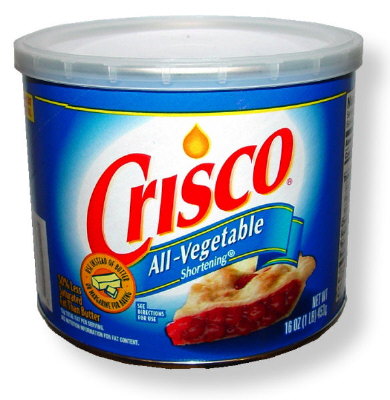On April 25, 2001, Procter and Gamble (P&G) put its product Crisco on the auction block, just ten years short of its 100th birthday. Crisco, initially made with hydrogenated cottonseed oil, is the quintessential imitation food, and the first to make its way into American kitchens.
The story of Crisco begins innocently enough in pre-Civil War America when candle maker William Proctor and his brother-in-law, soap-maker James Gamble, joined forces to compete with fourteen other soap and candle makers in Cincinnati, Ohio. P&G entered the shortening business out of necessity. In the 1890s, the meat packing monopoly controlled the price of lard and tallow needed to make candles and soap.1 P&G took steps to gain control of the cottonseed oil business from farm to factory. By 1905, they owned eight cottonseed mills in Mississippi. In 1907, with the help of German chemist E. C. Kayser, P&G developed the science of hydrogenation. By adding hydrogen atoms to the fatty acid chain, this revolutionary industrial process transformed liquid cottonseed oil into a solid that resembled lard.1
Not content with using hardened cottonseed oil for soaps, and mindful that electrification was forcing the candle business into decline, P&G looked for other markets for their new product. Since hydrogenated cottonseed oil resembled lard, why not sell it as a food?
The new product was initially named Krispo, but trademark complications forced P&G to look for another name. They next try was Cryst which was abandoned when someone in management noted a religious connotation. Eventually they chose the near-acronym Crisco, which can be derived from CRYStalized Cottonseed Oil.
Crisco was introduced to the public in 1911. It was an era when wives stayed home and cooked with plenty of butter and lard. The challenge for Crisco was to convince the stay-at-home housewife about the merits of this imitation food. P&G’s first ad campaign introduced the all-vegetable shortening as “a healthier alternative to cooking with animal fats. . . and more economical than butter.” With one sentence, P&G had taken on its two closest competitors—lard and butter...
... We also didn’t know that the partially hydrogenated oils in Crisco—the trans fatty acids—were bad for us. In fairness to P&G, they didn’t know this either, not at first. But when reports of problems began to appear—problems like increased heart disease, increased cancer, growth problems, learning disorders and infertility—P&G worked behind the scenes to cover them up. One scientist who worked for P&G, Dr. Fred Mattson, can be credited with presenting the US government’s inconclusive Lipid Research Clinics Trials to the public as proof that animal fats caused heart disease. He was also one of the baleful influences that persuaded the American Heart Association to preach the phony gospel of the Lipid Hypothesis. The truth about the dangers of trans fatty acids in foods like Crisco is finally emerging. Perhaps that is why P&G decided to put their flagship product up for sale.


